An Inside Look at Urban Farming
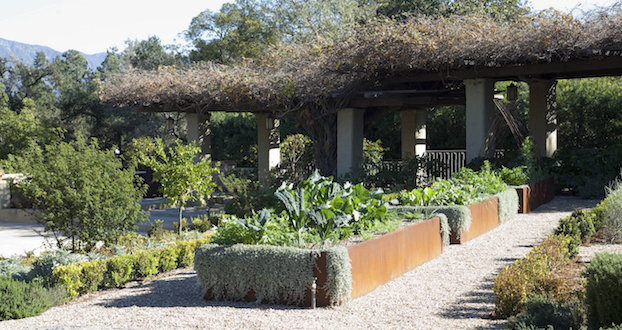
By Lara Hermanson
Landscapers have a multitude of resources at their fingertips when it comes to traditional irrigation practices. Professional wholesalers have long been assets regarding sprinklers and drip irrigation. Similarly, out on the farm, there are common drip tape strategies employed to irrigate monoculture row crops. Launching in Southern California in 2009, Farmscape combined the multitude of traditional practices and new eco innovations to grow food crops in very unlikely spaces.
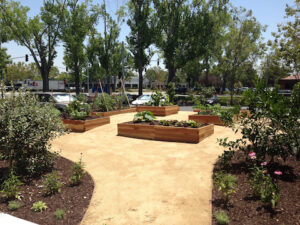 As the largest urban farming company in the United States, Farmscape CEO Dan Allen has aspired to bring the farm back to the city, one project at a time. More than 700 urban farms have been installed since then. Initially, many of these projects were residential, and consisted of one or two raised vegetable beds in the corner of a traditional suburban lawn, but then attracted commercial businesses. All the normal irrigation practices applied-in these cases: we would just install a new valve with pressure regulator to extend drip irrigation to the garden, and cap the lawn sprinklers.
As the largest urban farming company in the United States, Farmscape CEO Dan Allen has aspired to bring the farm back to the city, one project at a time. More than 700 urban farms have been installed since then. Initially, many of these projects were residential, and consisted of one or two raised vegetable beds in the corner of a traditional suburban lawn, but then attracted commercial businesses. All the normal irrigation practices applied-in these cases: we would just install a new valve with pressure regulator to extend drip irrigation to the garden, and cap the lawn sprinklers.
Generally, for raised beds, Farmscape uses 1/4-inch in-line emitter tubing, with emitters spaced every 6 inches. Easy, right? But we discovered that while drip is the best application for growing food crops, it is sub-par for germinating seeds.
Adapting germination strategies
Some food crops, such as beans, peas, squash and melons, are easy to germinate. The seeds are large, simple to plant, and have wide spacing: 6, 12 or 18 inches. Using the standard 1/4-inch in-line emitter tubing, we plant the seeds directly under the emitters. Then we adjust the timers to water for one minute, three to four times per day, to keep the soil around the seed regularly moist. While this watering schedule is great for germinating seeds, it is not sustainable, and needs to be adjusted as soon as the seeds sprout. Also, if other larger plants are simultaneously growing in the beds, they will either be over or under watered by this system. For that reason, we remove all the plants from the bed at every season switch (in California: twice per year) and re-seed all at once. If we can’t re-seed simultaneously, we tie in a micro-sprayer to moisten just one section of a raised bed if we’re sprouting seeds later in the season. As soon as the seeds sprout, this line will need to be capped.
Water preservation and drought processes
As the California drought worsened in the earlier part of this decade, more clients asked us to replace sections of their lawns with low-water landscape or grapes and fruit trees. Their logic being that if they’re using landscaping water, it may as well be for something they can eat. To that end, Farmscape experimented with different methods of irrigating home fruit trees. The advice other landscapers offered tended to favor establishing two bubblers on either side of the fruit tree. Another method was creating drip rings out of Netafim, giving the tree six to eight emitters, moistening all sides of the root ball. Over time, this became our preferred method, and created healthier fruit trees, with better production at lower water costs to our customers.
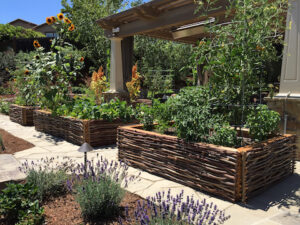 Many homeowners ask us to plant around the basin of the fruit tree, or add in ground cover to potted fruit trees. From an irrigation standpoint, it’s not so feasible since fruit trees need frequent deep watering when planted, tapering off to an infrequent (once or twice per month) deep watering. There’s not a lot of ground cover that can accommodate that sort of watering schedule, as these types of plants (even low-water varieties) require weekly watering. The ground cover shows signs of under-watering quickly, and as landscapers move to correct it, the tree suffers from overwatering: specifically, too frequent shallow watering. This creates a prime environment for pest and disease issues to fester around the trunk. Additionally, these trees will have an immature root system, and, over time, it will respond with yellow leaves and branches, misshapen and subpar fruit and, eventually, an ugly death!.
Many homeowners ask us to plant around the basin of the fruit tree, or add in ground cover to potted fruit trees. From an irrigation standpoint, it’s not so feasible since fruit trees need frequent deep watering when planted, tapering off to an infrequent (once or twice per month) deep watering. There’s not a lot of ground cover that can accommodate that sort of watering schedule, as these types of plants (even low-water varieties) require weekly watering. The ground cover shows signs of under-watering quickly, and as landscapers move to correct it, the tree suffers from overwatering: specifically, too frequent shallow watering. This creates a prime environment for pest and disease issues to fester around the trunk. Additionally, these trees will have an immature root system, and, over time, it will respond with yellow leaves and branches, misshapen and subpar fruit and, eventually, an ugly death!.
While clients are committed to this aesthetic, we encourage them to keep fruit trees and ground plantings separate. Think about how trees grow on an expansive orchard: there is no plant matter competing with them, which is ideal for fruit production. For clients that crave that Tuscan look, we suggest planting at least a 24-inch box fruit tree with an existing mature root system. We plant very low-water succulents around the edge of the pot, keeping a few inches bare around the trunk to apply fertilizer and reduce mold and disease. Farmscape irrigates these with drip rings rather than micro sprayers – the latter encourages trunk mold and disease.
More than just backyard gardens
Residents wanting to enjoy fruit and vegetable gardens are becoming common as more homeowners opt to grow food in their backyard – and they’re not alone. Commercial properties, stadiums, and multi-family developments have jumped on this holistic trend while learning how to conserve water in the process. One such location is the Levi’s Stadium rooftop, where Farmscape has installed a 6,300-square-foot rooftop farm, using 100 percent drip irrigation and recycled water.
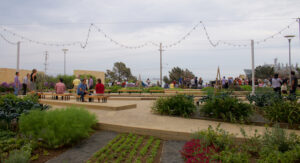 Many people ask how we’re able to grow food with water that has been, ahem, previously used, accounting reclaimed water system methods are standard in many countries such as Israel, Australia and South Africa. Locally, the Silicon Valley Advanced Water Purification Center (SVAWPC), operated by the Santa Clara Valley County Water District, is a state-of-the-art water purification plant that takes recycled water from the San Jose-Santa Clara Regional Wastewater Facility and purifies it to meet even higher environmental quality standards. At the SVAWPC, recycled water goes through three purification processes: microfiltration, reverse osmosis, and ultraviolet light. Water gets plumbed back to Levi’s Stadium where it irrigates the farm and the football field.
Many people ask how we’re able to grow food with water that has been, ahem, previously used, accounting reclaimed water system methods are standard in many countries such as Israel, Australia and South Africa. Locally, the Silicon Valley Advanced Water Purification Center (SVAWPC), operated by the Santa Clara Valley County Water District, is a state-of-the-art water purification plant that takes recycled water from the San Jose-Santa Clara Regional Wastewater Facility and purifies it to meet even higher environmental quality standards. At the SVAWPC, recycled water goes through three purification processes: microfiltration, reverse osmosis, and ultraviolet light. Water gets plumbed back to Levi’s Stadium where it irrigates the farm and the football field.
Farmscape has opted to irrigate this row-cropped rooftop farm with Netafim versus drip tape, which is what you would use on a traditional row cropped farm. The reason here is mainly for peace of mind. Drip tape regularly tears and leaks. That’s not a big deal on a farm, but it’s huge when you are farming on top of a NFL press box.
Nature and nurture of irrigation
Another quasi-irrigation solution for select projects is adding biochar to our rooftop gardens. Biochar is a fine charcoal made from biomass (green waste) burned in the absence of oxygen – a process called pyrolysis. The concept for biochar came from studying rich Amazonian soils produced by the regenerative agricultural practices of indigenous people. This included burning biomass in trenches that were covered with soil. The charcoal created through this process was slowly incorporated into the soil, with the help of decomposers (such as worms). Over time this led to dark, fertile soils that reportedly retained their nutrient content for many years.
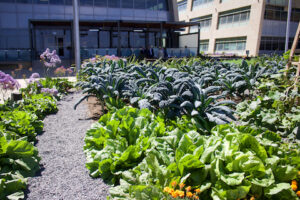 The benefits include carbon sequestration, increased soil fertility, and increased agricultural yields. But it also holds water in the soil by retention in small grooves of the charcoal, allowing tiny root hairs to access moisture, and preventing runoff. This is critical when trying to reduce the amount of nitrogen entering waterways in the Bay Area. Separately, the ability to enhance soil fertility through traditional means – adding soil and compost – is limited at Levi’s Stadium due to the weight-bearing capacity of the roof. This makes biochar a promising soil alternative as it is lightweight.
The benefits include carbon sequestration, increased soil fertility, and increased agricultural yields. But it also holds water in the soil by retention in small grooves of the charcoal, allowing tiny root hairs to access moisture, and preventing runoff. This is critical when trying to reduce the amount of nitrogen entering waterways in the Bay Area. Separately, the ability to enhance soil fertility through traditional means – adding soil and compost – is limited at Levi’s Stadium due to the weight-bearing capacity of the roof. This makes biochar a promising soil alternative as it is lightweight.
Recycled water has become more prevalent at our projects across the Bay. Currently, Farmscape has 10 large commercial projects using it. While the quality varies from site to site, the combined quality has improved over the past five years. There tends to be slightly more salt and/or calcium in the water, and so the key is to use quality water filters and clean them often. We find the standard 3/4-inch 140 mesh inline disc filter to be the right starting point for any project with recycled water. If we are still finding the emitters are clogging, we swap them with Amiad filters.
Learning to irrigate food crops in a variety of challenging city settings has been an interesting journey during the past decade. We’ve seen the rise of edible gardens in major metropolitan areas by residents who formerly lived in the suburbs but crave a piece of farm life in their backyard. Or for stressed city dwellers who are looking for new ways to decompress with nature. Farmscape has researched heavily into this growing mainstream trend, and produced logical applications for cost-effective urban farming maintenance. This is alongside educating home and business owners on the importance of environmentally friendly practices we use as standard – to not only keep their utility bills low, but also become more eco-conscious within the city.
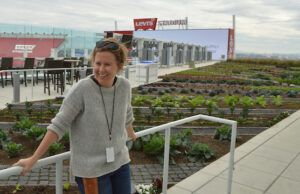 Lara Hermanson is co-founder and principal at Farmscape, the nation’s largest urban-farming company. Farmscape has worked on more than 600 urban farming projects including Levi’s Stadium, AT&T Park, and Oracle. A look at select Farmscape clients is available on https://farmscapegardens.com/portfolio.
Lara Hermanson is co-founder and principal at Farmscape, the nation’s largest urban-farming company. Farmscape has worked on more than 600 urban farming projects including Levi’s Stadium, AT&T Park, and Oracle. A look at select Farmscape clients is available on https://farmscapegardens.com/portfolio.
To learn more about how to irrigate an urban farm, visit the Farmscape blog at https://farmscapegardens.com/blog


